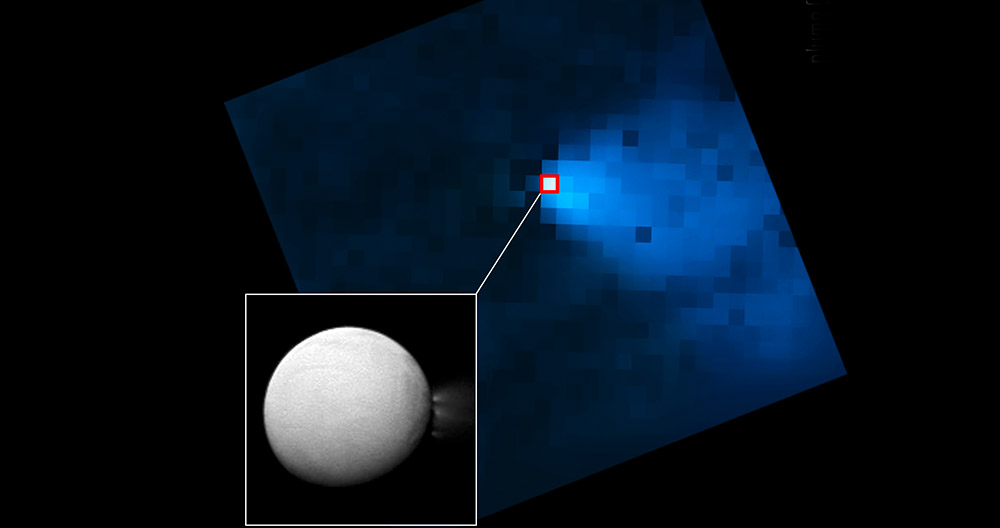Prolific Gargoyle: Saturn’s moon Enceladus has surprisingly large amounts of water in the Saturnian system, new observations using the James Webb Space Telescope reveal. A fountain of water appears more than 9,600 kilometers into space – 20 times the diameter of the Moon. The geysers at Enceladus pump out about 300 liters of water per second, thus creating their own water ring around Saturn, astronomers report in Natural Astronomy.
At just 505 kilometers wide, Saturn’s moon Enceladus has it all. Because beneath its icy crust is an ocean of mineral-rich alkaline water that may even contain hydrothermal vents. Huge geysers of this water seep into space through fissures and geysers at the moon’s south pole – the so-called tiger stripes. Pictures taken by NASA’s Cassini space probe showed fountains hundreds of kilometers long.
Water fountain as long as all of Eurasia
But the true extent of Enceladus’ “gargoyles” has only now been revealed by new images from the James Webb Space Telescope. “When I first saw the data, I thought it was wrong,” says first author Geronimo Villanueva of NASA’s Goddard Space Flight Center. The telescope’s NIRSpec spectrograph showed a more than 9,600-kilometer-wide fountain of water vapor, which shot into space from the south pole of Saturn’s moon.
When applied to Earth, the fountain of water ejected by Enceladus would be long enough to reach from Ireland to Japan. “It was amazing to see a spring of water more than 20 times the size of the moon,” Villanueva said. This is the first time that a fountain has been detected that has reached space at Saturn’s moon so far.
Ten quadrillion water molecules per second
However, the amount of water that is released into space from the polar “tiger stripes” is also amazing: according to data from the Webb telescope, more than ten quadrillion water molecules are released there every second. This corresponds to about 300 liters per second. This has consequences: “In Webb’s notes, we didn’t just see this giant fountain—there was water everywhere,” says Villanueva.
The water ejected by Enceladus spreads throughout its orbit, forming a ring of water vapor that once circles Saturn. Enceladus orbits Saturn relatively quickly, taking only 33 hours to complete one orbit. “She’s pulling a toroidal halo out of the water behind her,” Villanueva explains. This torus of water is inclined a good 15 degrees from Enceladus’ orbit and is nearly level with Saturn’s E ring.
How does the Enceladus fountain irrigate the Saturn system?© NASA/ESA, Webb
Water half of the Saturnian system
“Webb’s observations clearly show for the first time the role that geysers of water vapor on Saturn’s moon played in shaping this torus,” said co-author Silvia Protopaba of the Southwest Research Institute (SwRI). Astronomers estimate that about 30 percent of the water ejected by Enceladus remains in Saturn’s water ring. However, the remaining 70 percent escapes and is distributed over large parts of the Saturnian system.
Enceladus is one of the most dynamic celestial bodies in the solar system and a key target in the search for extraterrestrial life, says co-author Christopher Glenn of SwRI. “Everything that happens on this moon never ceases to amaze us.
What is hidden in the vicinity of Enceladus?
The team plans to study Enceladus and its water fountains more closely next year using the James Webb telescope. “We will then look for specific indicators of habitability, such as organic signatures and hydrogen peroxide,” explains Glenn. These analyzes could also provide more information about the nature of the liquid ocean beneath Enceladus’ crust and whether there is life there.
“Because of Webb’s sensitivity and wavelength coverage, we now have completely new possibilities,” says co-author Stephanie Milam of NASA. (Nature Astronomy, accepted)
Source: Space Telescope Science Institute, Baltimore

“Social media evangelist. Baconaholic. Devoted reader. Twitter scholar. Avid coffee trailblazer.”







More Stories
European Space Agency image showing “traces of spiders on Mars”
Resident Evil 9: Release will likely be delayed internally, insiders say
Manor Lords starts out with impressive player sales numbers and records